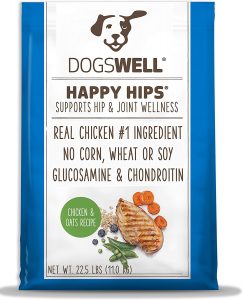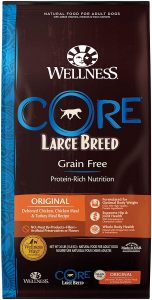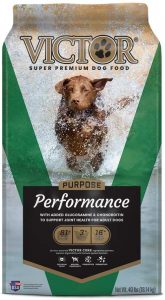Table of Contents
- Breeds that are susceptible to Arthritis and Hip Dysplasia– best dog food for hip dysplasia
- Causes of Hip Dysplasia in Dogs– best dog food for hip dysplasia
- Symptoms of Dog Hip Dysplasia– best dog food for hip dysplasia
- Symptoms of Arthritis in Dogs– best dog food for hip dysplasia
- Canine Treatment Options– best dog food for hip dysplasia
- Prevention & Maintenance- best dog food for hip dysplasia
- Frequently Asked Questions About Hip Dysplasia– best dog food for hip dysplasia
- Top three best dog food for hip dysplasia
- Final Thoughts
Hip dysplasia is a bone disease that often occurs in large and giant dog breeds, although it can also happen in smaller dogs, specifically pugs. The occurrence of hip dysplasia is a result of ball and socket not fitting together. Instead of the joints moving effortlessly through the ball and socket, it grinds against each other. As time passes, the ill-fitting hip joints will begin to degrade and deteriorate, causing immense pain. It is crucial to know the best dog food for hip dysplasia if your dog is suffering from this condition to mitigate its effects.
| PRODUCT | BRANDS | EXPERT RATING | CHECK PRICE |
|---|---|---|---|
 | Dogswell Happy Hips | Check Price |
|
 | Wellness CORE - Fit for Large Breeds | Check Price |
|
 | Victor Performance | Check Price |
Breeds that are susceptible to Arthritis and Hip Dysplasia– best dog food for hip dysplasia

There are several breeds that are susceptible to hip dysplasia. The top 10 dog breeds that are most likely to suffer from this disease are:
- Bulldog
- Pug
- Old English Bulldog
- Dogue De Bordeaux
- Neapolitan Mastiff
- Brussels Griffon
- St. Bernard
- Otterhound
- Spaniel
- Black Russian Terrier
Causes of Hip Dysplasia in Dogs– best dog food for hip dysplasia
Hip Dysplasia is genetically inherited and passed down over generations. This condition occurs even if both parents have zero hip dysplasia, so there is no guarantee that your dog won’t have this condition when you purchase them. Although, as mentioned before, some breeds do have a predisposition for hip dysplasia.
The second top reason for this condition is when puppies grow at an alarming rate. If the puppies are not fed properly to control their growth spurt, they will likely develop this condition. Quick growth causes a significant strain on their bodies. When too much growth happens, it often results in skeletal ailments such as hip or elbow dysplasia and other bone disorders.
Symptoms of Dog Hip Dysplasia– best dog food for hip dysplasia

It is crucial to note that not every dog will show symptoms of hip dysplasia. But, a majority of dogs will show signs of discomfort as the disease progresses. Symptoms can be mild and may be undetectable.
The following is a list of signs of hip dysplasia in dogs:
- Your dog will have pain when getting up.
- They have reduced activity and mobility.
- You can see them limping.
- Your dog will have a narrow stance.
- There is a change in gait, and your dog’s hip will tend to sway more.
- There is a loss of leg muscle.
- They have difficulty climbing stairs.
- You see obvious pain and stiffness in their movements.
- There are changes in their personalities, such as being more distant or aggressive
Symptoms of Arthritis in Dogs– best dog food for hip dysplasia
As dogs reach their senior years, they will tend to develop arthritis regardless of whether they have hip dysplasia.
Signs of arthritis in dogs are often similar to hip dysplasia. But arthritis occurs in more than just one hip region. Often, dogs that suffer from hip dysplasia also develop arthritis on the hips and other body areas.
The following are symptoms of arthritis in dogs:
- Pain
- Your dog will have difficulty standing up
- There is prolonged stiffness after rest
- You will notice limping or lameness
- The dog experiences discomfort when touched
- Your dog has difficulty managing stairs and jumping
- There is reduced activity and mobility
- They don’t have the inclination to play or be active
- There is a loss of muscle
- Your dog has changes in personality
- They lick painful areas
Canine Treatment Options– best dog food for hip dysplasia

There are many treatment options for dogs with hip dysplasia. The seriousness of the disease, the size of your dog, and the dog’s age contribute to choosing the best cure. Your vet will help guide you to the best treatment course.
For serious cases, the most effective way to regulate hip dysplasia is via surgery.
Top surgical treatment options include the following:
DPO/TPO
This is a surgical procedure often used for younger and less than 10 months old dogs. This treatment aids dogs for the improvement of the function of their hip joints.
FHO
The SHO surgical option can be an intervention for young and adult dogs. Unlike the previous entry, it doesn’t allow for normal use of the hip. This procedure is more surgically invasive and cuts out the femur to match the joint.
THR
This acronym stands for total hip replacement. This treatment is a very effective solution; however, it does not last as long as the other interventions.
Prevention & Maintenance- best dog food for hip dysplasia
Preventive measures can reduce hip dysplasia, but there is no guarantee that the methods will entirely prevent this disease’s onset.
Weight Management
It is crucial to ensure that your dog’s weight is regulated and help your dog’s overall well-being. The stress of excess weight can intensify symptoms connected to hip dysplasia.
Physical Therapy
Therapy is crucial and can help regulate and build needed muscle in your dog’s body and maintain or increase their activity and mobility.
Anti-Inflammatory Medications
Many anti-inflammatory medications can help alleviate swelling and discomfort. Gabapentin and Carprofen are common anti-inflammatory medications.
Acupuncture
Subjecting your dog to acupuncture can help minimize inflammation and regulate pain.
Cold Laser Therapy and Ultra-Sound Therapy
These procedures can help minimize inflammation.
Monitor Your Dysplastic Dog
Sadly, hip dysplasia is not curable, and it has to be constantly monitored. Many dogs learn to live with this condition; however, they require care and maintenance.
As they reach their senior years, the condition becomes worse. For this reason, many pet owners need to check their canine at all times. You should be able to identify signs of discomfort and pain. If you are not sure whether your pet is suffering from this condition, take them to the vet.
Practice Responsible Breeding
As discussed before, diet and exercise can significantly affect your dog’s health. But they will also need prevention and management.
As an example, a top-quality nutritious diet that contains a lot of vitamins and minerals will help with bone health and help your dog become more active and mobile.
Besides, if your dog is already suffering from dysplastic symptoms, you should focus on giving them mild exercises. If you have a healthy dog, make sure regular exercise is part of their daily routine.
Avoid Overfeeding
Breeding a dog is a tough obligation, and it often begins when you choose a specific dog. Knowing the proper nutrition specific to the breed is an important step. You need to have a thorough knowledge of their growing habits, so you can help them develop properly.
For example, if you want to feed your dog with a higher calorie and higher protein diet, you should first ask your vet. They will recommend an ideal nutrition plan that can stop numerous health conditions, such as obesity and diabetes.
Moderate Exercise
One solution to maintain your pet’s health is moderate exercise and low impact activities.
As an example, larger breeds should not excessively jump or engage in any exercise that strains their back and legs. Doing these can lead to deterioration of joints and speed up any bone ailments. You should ask your vet if you want your pet to do physical activities. They will give you the ideal type of exercise for your dog.
Frequently Asked Questions About Hip Dysplasia– best dog food for hip dysplasia
Can massage help relieve the pain of my dog?
Yes, there are special massages that can benefits canines. First of all, you need to have a comfortable flat surface for your dog to lie down on. Afterward, carefully begin to apply pressure on the hip area by massaging it with the pads of your fingers. The force should be gentle enough, and your pet will let you know how much pressure they can handle. If you notice that they are crying out, then you should stop at once.
Is it safe to use heating pads for dogs?
These days there are a huge number of heating pads you can choose from. Many of them come with resistance cords as well as temperature control. You have the option to choose an electrical or nonelectrical unit.
Heating pads are not dangerous to dogs. The heat they emanate can ease joint pain as well as joint pressure. Additionally, it can also help warm up your puppies during the colder months.
Top three best dog food for hip dysplasia
OUR TOP PICK!
OUR TOP PICK!

Product Name: Dogswell Happy Hips
Product Description: Dogswell best dog food for hip dysplasia has a stellar reputation in the pet food industry. It is the ideal choice for you. They carefully select their ingredients, making this dog food one of the top choices on the market. Chicken is the primary component in this best dog food for hip dysplasia combined with fresh vegetables and oats. Besides, the recipe for this best dog food for hip dysplasia includes glucosamine and Chondroitin to promote mobility and maintain healthy joints. It should be noted that this nutrition is formulated for older dogs. For this reason, included in the mix are probiotics and prebiotics, which improve the immune system and offer digestive support.
Offer price: 17
Currency: usd
Availability: InStock
-
Nutrition
-
Taste
-
Ingredients
Overall
Summary
If your dog is a picky eater, this glucosamine and Chondroitin can stimulate your pet’s appetite and reduce the occurrence of allergies. Additionally, blueberries and tomatoes come as a natural source of antioxidants. Overall, many pet owners reported this best dog food for hip dysplasia has helped with their weight management and improved their mobility.
Pros
Supports healthy hips and joints
Has Real superfood fruits and vegetables
Offers healthy carbohydrate sources
Cons
No negative reviews so far
Runners Up
Wellness CORE - Fit for Large Breeds

Larger breeds are particularly prone to sensitivity to certain ingredients included in dog food. For this reason, one of their requirements are specially formulated diets that aid in bone and joint health.
Fortunately, Wellness core natural best dog food for hip dysplasia is an ideal solution. The recipe in this best dog food for hip dysplasia will give your pets all the top-notch nutrients to keep them healthy and active. It comes with high-quality proteins such as chicken and beef as well as turkey and chicken meals. It will please you to know that this best dog food for hip dysplasia doesn’t utilize cheap fillers or meat byproducts.
Additionally, your canine will have the benefit of experiencing the well flex system that aids in joint health. Included in the mix are Omega fatty acids, antioxidants, and probiotics, which help aid in digestion and protect the immune system.
Overall, this best dog food for hip dysplasia helps your dog keep an active lifestyle, so make sure to test out this brand’s recipe.
This best dog food for hip dysplasia utilizes premium protein, which is expertly balanced and includes nutrient-rich superfoods for a boost and well-balanced dog food nutrition. It has high levels of nutrients for larger breeds to thrive healthily.
Victor Performance

If your dog is constantly hungry because they are energetic, then Victor performance best dog food for hip dysplasia will satisfy all their dietary requirements. The high-quality proteins present in this best dog food for hip dysplasia come from beef, pork, and chicken meal. Glucosamine, which is included in the mix, aid in joint health.
Additionally, proteins will aid in muscle development and give your pet their much-needed energy requirements.
Even though this best dog food for hip dysplasia has top-notch quality, it is quite affordable. Dogs with food sensitivities can tolerate this recipe well. In recent times Victor performance has gotten a lot of attention because it has zero GMO grains and meat byproducts. But finicky eaters might need to adjust and get used to this recipe.
Overall, you are getting an excellent deal with Victor performance best dog food for hip dysplasia. This recipe will not only enhance your pet’s health, but it will also contribute to their overall well-being.
Victor performance is a top choice for older dogs with high physical requirements since they will need energy and stamina. This best dog food for hip dysplasia utilizes multi-protein sources and has a dense nutrient formula, specially targeted for older dogs and larger breeds that are vulnerable to joint diseases.
Victor performance for dogs is made to meet the nutritional requirements established by the AAFCO.
Final Thoughts
If you see your dog suffering from hip dysplasia, you will be feeling their pain too because of your special bond with them. It is crucial to give them the necessary intervention to help them lead a long and comfortable life. If you see signs of hip dysplasia, take them for a vet checkup at once. Your vet will recommend lifestyle changes and the best dog food for hip dysplasia for the care and maintenance of your canine.
